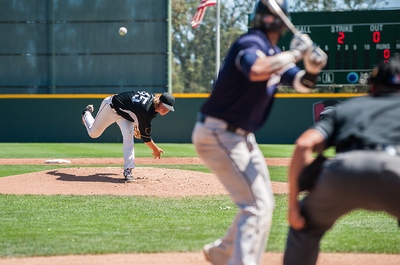 Many people in the UK are familiar with the sport of baseball on a superficial level, but it is not a sport that has captured hearts and minds in the same way that other bat and ball games such as tennis or cricket have.
Many people in the UK are familiar with the sport of baseball on a superficial level, but it is not a sport that has captured hearts and minds in the same way that other bat and ball games such as tennis or cricket have.
People will no doubt be aware of the basic concept of the sport, perhaps having seen it featured in such movie classics as Field Of Dreams, A League Of Their Own and, more recently, Moneyball.
But in this article, we’ll dig under the surface of baseball and explain a little more of the details of this classic American game. Specifically, we’ll explain whether every player in a baseball team has to bat and pitch.
Before that, let’s just run through the basics of this bat and ball game.
Baseball Basics

The basic concept of baseball is fairly simple: it’s essentially a variation on the game of rounders (from which baseball almost certainly developed). That is to say, there are two teams with nine players on each team, one of whom bats, the other pitches and fields. The player who is batting stands in the batting box near to the home plate and uses a baseball bat (a wooden or metal club) to attempt to hit the ball that is propelled (pitched) towards him by the pitcher.
Without going into all the details, if the batter hits the ball (the right side of the foul line) he can try to run to the first base, and assuming the ball wasn’t caught before it hit the ground, he can continue running to second base, third base and then back to the home plate. If he makes it back to the home plate without getting out, his side scores a run.
The home plate and the three bases are arranged as the corners of the “baseball diamond” and a batter can stay on any of the three bases and be “safe”, hoping that the next batter will hit the ball sufficiently hard to allow them to run through the remaining bases and back to the home plate. Every player on the batting side that makes it back to the home plate earns his side a run.
The pitching and fielding side is, of course, attempting to stop the batting side scoring runs and also to get the players out. As with cricket, if a batter hits the ball (the right side of the foul line) and one of the fielders catches it before it hits the ground, the batter is out. They can also be out if they swing to hit the ball and miss three times or the pitcher throws the ball in the strike zone and the batter does not swing. This would be a strikeout. Additionally, players can be tagged out if they are tapped with the ball (while it is in a fielder’s hand) when they are between bases, i.e. not safe. There are other ways to get out, but they are the basics.
When three players from the side that is batting are out, the whole team is out. At this point, the teams switch, so the team that was batting will pitch and field and the other team will bat. When both sides have batted (and hence also pitched and fielded) then one innings has been completed. In a standard Major League Baseball (MLB) match there are nine innings. In the case of a tie after the prescribed nine innings each, it is standard practice to add additional innings until one side or the other has won, something we cover in more detail in another article on this site.
Now we’ve got the basic gameplay under our belts, let’s turn to the more specific details about which players bat and which pitch and whether all players need to do both or either during a baseball match.
Batting In Baseball: Who, When, How?
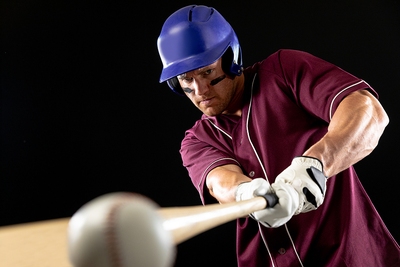 Now we know the batter from one side faces the pitcher from the other side, much like a batsman in cricket facing the opposition bowler. But is there a specific order of who bats when and does every player in the team have to bat? Team managers must present the batting order of their team five minutes before the start of a match to the umpire in the form of a lineup card; a copy should also be given to the opposing manager. Once the batting order has been submitted, it is final and both teams must stick to their specified order.
Now we know the batter from one side faces the pitcher from the other side, much like a batsman in cricket facing the opposition bowler. But is there a specific order of who bats when and does every player in the team have to bat? Team managers must present the batting order of their team five minutes before the start of a match to the umpire in the form of a lineup card; a copy should also be given to the opposing manager. Once the batting order has been submitted, it is final and both teams must stick to their specified order.
In fact, according to the Official Baseball Rules, if a team bats out of order, which is to say that a player goes to the home plate to face the pitcher when it is not his turn, various penalties can apply including the player being declared out or having a strike against them.
The only way the players in the batting order can be changed is through substitutions. If a player is substituted, either for injury or tactical reasons, his place in the order will be taken by the player for whom he was substituted. Hence the batting order itself doesn’t actually change, just the personnel within the existing order.
Which Player Bats First In Each Innings?
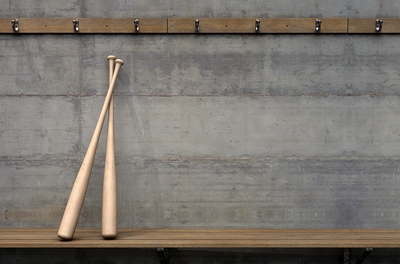 At the start of a baseball match, the first player to bat for the batting side is the one at the top of the order, the first name on the lineup card. But what about subsequent innings? If baseball followed a similar system as cricket, in the second and subsequent innings, the player at the top of the order would be the first to bat again. But this is not the case with baseball. Instead, as stated in the aforementioned Official Baseball Rules:
At the start of a baseball match, the first player to bat for the batting side is the one at the top of the order, the first name on the lineup card. But what about subsequent innings? If baseball followed a similar system as cricket, in the second and subsequent innings, the player at the top of the order would be the first to bat again. But this is not the case with baseball. Instead, as stated in the aforementioned Official Baseball Rules:
The first batter in each inning after the first inning shall be the player whose name follows that of the last player who legally completed his time at bat in the preceding inning.
Based on this, the player who bats first in the second inning will depend on how his team performed in the first. So, for example, if a team had an appalling first inning and the first three players on the lineup card were suffered strikeouts, the first player to bat in their second inning would be the one who was fourth on the list.
As such, given that the fielding side must get three batting players out in each of the innings, and given that there are nine innings (in an MLB match at least), it is therefore safe to say that all players in a baseball team will need to bat… unless they are substituted before they face the pitcher, of course. Speaking of the pitcher (of which we shall explain more later), that brings us to the notion of the designated hitter, which is a situation whereby another member of the team is not required to bat.
What Is A Designated Hitter?
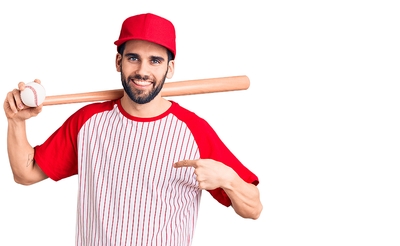 Until relatively recently it was standard practice for the main pitcher to also bat in a given game of baseball. But since a rule change (Rule 5.11 of the Official Baseball Rules, to be precise), in 1973 it has been possible to use a so-called designated hitter who takes the place of the main pitcher in the batting lineup, thus allowing the pitcher to focus on his duties (and avoid the opposition pitcher pounding him with fastballs in the hope of causing him some kind of injury!).
Until relatively recently it was standard practice for the main pitcher to also bat in a given game of baseball. But since a rule change (Rule 5.11 of the Official Baseball Rules, to be precise), in 1973 it has been possible to use a so-called designated hitter who takes the place of the main pitcher in the batting lineup, thus allowing the pitcher to focus on his duties (and avoid the opposition pitcher pounding him with fastballs in the hope of causing him some kind of injury!).
The pitcher is arguably the most specialist position in a baseball team and the one player for whom little is typically expected when they come to bat. As such, being able to remove them from the batting lineup entirely is often very beneficial. In addition, because the designated hitter does not have to field, it is a good way to get a player who is a fine batter but a poor fielder into the lineup.
It’s worth noting that of the two leagues in Major League Baseball, only the American League adopted the designated hitter rule from 1973, while the National League continued with the pitcher also batting. When matches take place between teams from the two leagues, the designated hitter rule preference of the home side comes into play for that game. The designated hitter rule is technically optional and teams can agree to adhere to it or not as long as such an agreement is made before the start of a game. But this means that in some professional baseball matches, not all players in a team will need to bat – the pitcher might well be exempt.
Baseball Substitutions And Batting
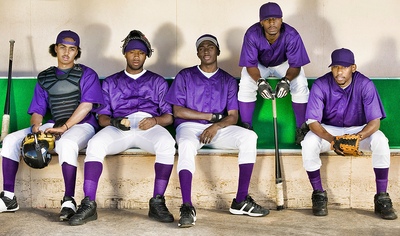 Fans of some other popular US sports such as basketball and American football might think they have found a loophole here. If you have a player who is an expert fielder but can’t bat for toffee, couldn’t the manager simply substitute him out when his side is batting and then sub him back in for when they are fielding?
Fans of some other popular US sports such as basketball and American football might think they have found a loophole here. If you have a player who is an expert fielder but can’t bat for toffee, couldn’t the manager simply substitute him out when his side is batting and then sub him back in for when they are fielding?
Well, no.
Unlike some other US sports, there are no “rolling” or “free” subs in Major League Baseball (and other professional leagues). As such, if a player is substituted off, he can play no further part in the game, just like with football (soccer).
With that in mind, it is possible for a player in a baseball team to not bat, for instance if they are sixth in the order and they are substituted before their turn. But they will play no further part in the game. Hence, all players in a baseball team will bat at some point in a match, as long as they are not substituted before their turn comes up or they are not a pitcher who doesn’t need to bat because a designated hitter is being used in the game.
Baseball Pitchers: Do They Take It In Turns?
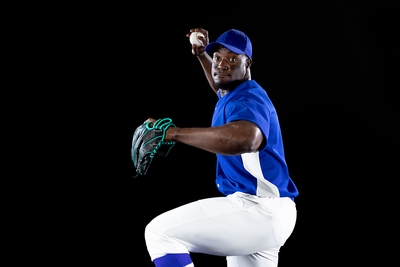 Now let’s turn our attention to pitchers and see how it compares to the rather rigid but thankfully (reasonably) straightforward rules of which players bat when. The pitcher is arguably the most important role in a baseball team. This is because pitching is the primary way to get opposition players out, and if you don’t get your opponents out, you cannot win the game. Indeed, when it comes to betting on baseball, many typical markets and odds are based on the named pitchers for both sides starting the game. Any late changes to a side’s main pitcher often render bets void, showing just how important this roll is.
Now let’s turn our attention to pitchers and see how it compares to the rather rigid but thankfully (reasonably) straightforward rules of which players bat when. The pitcher is arguably the most important role in a baseball team. This is because pitching is the primary way to get opposition players out, and if you don’t get your opponents out, you cannot win the game. Indeed, when it comes to betting on baseball, many typical markets and odds are based on the named pitchers for both sides starting the game. Any late changes to a side’s main pitcher often render bets void, showing just how important this roll is.
A top quality pitcher can certainly make life difficult for batters, often by mixing up the types of pitches they throw from fastball to curveball to slider and others. Of course, a pitcher who isn’t on top of his game could well end up losing the game for his side if his pitches keep getting smacked out of the park.
Unlike a cricket team, which will tend to have at least three specialist bowlers and sometimes as many as five, a baseball team would usually include just a single pitcher, at least in the starting lineup. Because pitching a ball repeatedly through several innings in a baseball match takes its toll on even the fittest, most supple bodies, there are also various so-called relief pitchers (effectively substitutes) who can come into the game in place of the starting pitcher if required. This could be because the pitcher who started the game become fatigued or they have picked up an injury, or it might be for tactical reasons (if they are not managing to avoid getting hit for runs, for instance).
As baseball matches come thick and fast in the MLB, sometimes even two in the same day, baseball franchises will usually have a group of pitchers from which they pick different starting pitchers for different games. Irrespective of which pitcher starts a given game though, it is very uncommon for a pitcher to last the full nine innings of a match without being replaced by a relief pitcher at some point. And it is fine for the team to replace the relief pitcher with another relief pitcher if they so choose, for example, if the new pitcher becomes injured or fatigued. Note that the original starting pitcher cannot return to the game after they have been substituted, however.
But while batting rotates through the full lineup (with the aforementioned exceptions), when it comes to pitching, it is not the case that everyone in the team gets to have a go. The highly specialised nature of pitching means that pitchers at the top of their game can concentrate 100% on their pitching (during games and training) rather than concerning themselves with batting. Not only that, pitchers who are also required to bat will face a greater risk of injury simply from having to run around the bases – and indeed facing the fastballs of their opponents!
In addition, the role of designated hitter has been filled by accomplished batters who are not necessarily good fielders, and hence if they were in a standard batting role and then had to field too, they could cost their team runs. With this in mind, it has been reported that the role of designated hitter has been a big boost to some players’ careers as they might otherwise have struggled to hold down positions in teams.
Baseball Batting and Pitching Conclusions
As we have seen, in many professional baseball games, every player in the lineup will need to bat at some point during the game. This is unless they are substituted before their turn to bat comes up or, in some leagues and games, if they are a pitcher who has a designated hitter to bat in their place. When it comes to pitching, there is no requirement to rotate the pitching duties through the team and specialist pitchers are used. These pitchers are generally replaced at some point during the game by relief pitchers (substitutes) and usually different pitchers are used to start games that occur close to one another.
